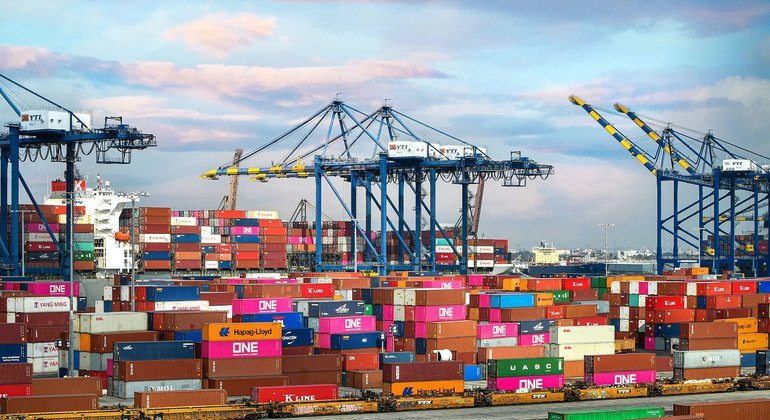The global economy will grow by just 2.4% in 2024, marking its third consecutive year of slowdown.

By the end of 2024, a growth of 2.4% The global economy could add the five years with the lowest GDP growth in the past three decadesThis was announced Tuesday World Bank In his report Economic forecasts.
The study indicates that growth in 2023 reached 2.6%, and warns that although the risk of a global recession has declined largely due to the strength of the United States economy, the study Rising geopolitical tensions could create new near-term risks for the global economy.
As A. describes Gloomy medium-term outlook for many developing economies Given the slowdown witnessed by most major economies, the slowdown in global trade, and the most restrictive financial conditions in recent decades.
Other factors that will pressure the economy include trade, whose growth for 2024 is estimated to be half the average in the decade before the pandemic, and the growth of the global economy. High cost of debt for developing economies.
Poorer than before the pandemic
The World Bank notes that after a disappointing performance in 2023, low-income countries will grow by 5.5%, less than expected, and that at the end of 2024, it is approaching 25% of developing countries and about 40% of low-income countries will be poorer than it was before the Covid-19 pandemic.
to Advanced economiesThe corporation expects growth to slow this year from 1.5% in 2023 to 1.2% this year.
The World Bank's chief economist, Indermeet Gill, explained that weak growth in the short term will push many developing countries, especially the poorest, to reach…“Devastating levels of debt and difficulty accessing food for nearly one in three people.”
“This will hinder progress on many global priorities,” Gill stressed. “but “There are still opportunities to change course.” He qualified and called on governments to act now to accelerate investment and strengthen fiscal policy frameworks.
Generating an investment boom
According to the report, developing countries need to address climate change and achieve other development goals by 2030 Increasing investment by about $2.4 trillion annuallyThis requires a comprehensive political package.
In this sense, he emphasizes that the global economy needs to generate a sustainable investment boom, and believes that, according to experience, developing economies Obtaining unexpected financial profits When it works to accelerate the growth of investment per capita to a level of no less than 4% and maintain it for at least six years.
The noticeable results of this type of investment are the accelerated pace of convergence with income levels in advanced economies, a Faster decline in the poverty rate Productivity growth increased fourfold. During these boom periods, inflation also falls, financial and external conditions improve, and people's ability to access the Internet expands rapidly.
Director of the World Bank's Forecast Group, Ayhan Kosi, said that investment booms have the potential to transform developing economies.Help them accelerate energy transformation and achieving a wide range of development goals.”
“To foster these booms, developing economies must fuel these booms They must implement comprehensive policy packages aimed at improving fiscal and monetary frameworksExpanding cross-border trade and financial flows, improving the investment climate, and enhancing the quality of institutions. It's hard work, but many developing economies have managed to do it. He stressed that achieving this goal again will help mitigate the slowdown in growth expected for the rest of this decade.
Latin America, the region with the lowest growth in 2024
In its analysis by region, the World Bank puts… South Asia as the region with the highest growth rates in 2024 at 5.6%, followed by East Asia and the Pacific at 4.5%.
Latin America and the Caribbean occupies the last step Regional growth forecast for this year is 2.3% and 2.5% in 2025.
After an advance of only 2.2% in 2023, The area will begin a slow and gradual recoveryThe report expects that although the continuing effects of restrictive monetary policy will continue to impact growth in the short term, its impact is expected to weaken.
As inflation declines, central banks will lower interest rates, which… It will reduce obstacles to increased investmentabound.
Divergent viewpoints
The study demonstrates and quantifies that views differ between countries in Latin America and the Caribbean The two engines, Brazil and Mexico, will record a slowdown of growth this year, by 1.5% in the Brazilian case and 2.6% in the Mexican case.
ArgentinaFor its part, it will recover to grow by 2.7% this year Colombia and Chile It will reach 1.8% in 2024.
Guyana will be the exception in the regionWith an expected growth of 38.2% thanks to the boom in exploitation of its natural resources.
Economies CaribbeanWithout Guyana, it will grow by 4.1% this year, partly due to the expansion of the tourism sector.
in Central America Growth is expected to reach 3.7%, supported by remittances.
Internal and external risks
The World Bank warns that long-term internal risks remain for the region as a whole, highlighting the situation Slowing productivity and aging populations.
In addition, it lists multiple external risks such as Rising geopolitical tensionsEspecially in the Middle East, it could hit energy markets and lead to higher oil prices.
Extreme weather eventsExacerbated by climate change, additional threats pose additional threats, particularly to climate-sensitive sectors such as agriculture, energy and fisheries. External factors and global trends also contribute to shaping the risk profile.
Also, quote Persistent inflation in advanced economiesThis could keep interest rates high for a long time, limiting monetary and fiscal policies in the region.
It is also estimated that A A sharper than expected slowdown in the Chinese economy It will have important effects on external demand, which will affect the region's exports of basic commodities.

“Award-winning zombie scholar. Music practitioner. Food expert. Troublemaker.”









